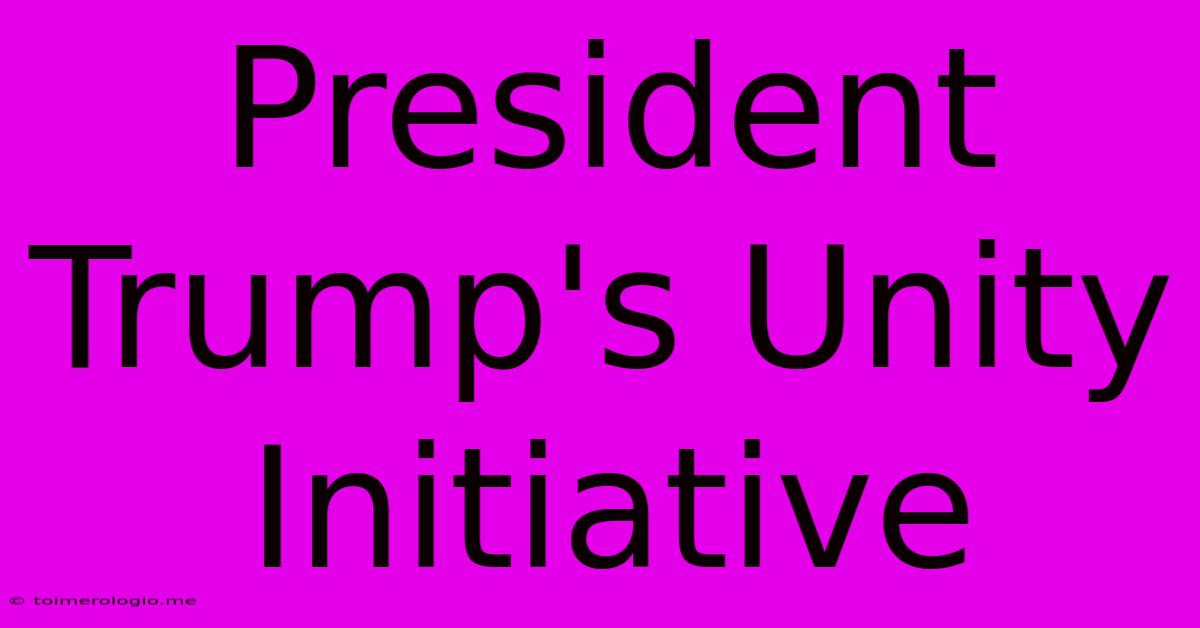President Trump's Unity Initiative

Discover more detailed and exciting information on our website. Click the link below to start your adventure: Visit Best Website toimerologio.me. Don't miss out!
Table of Contents
President Trump's Unity Initiative: A Deep Dive into its Aims, Impact, and Controversies
Donald Trump's presidency, marked by significant political polarization, also saw the launch of several initiatives aimed at fostering national unity. While the efficacy and even the sincerity of these efforts remain highly debated, understanding the context, goals, and consequences of these "unity" initiatives is crucial to comprehending the Trump era and its lasting impact on American politics. This article delves into the various aspects of President Trump's approach to national unity, analyzing its strengths, weaknesses, and enduring legacy.
Understanding the Context: A Nation Divided
Before examining specific initiatives, it's essential to acknowledge the deeply divided political landscape Trump inherited. Decades of increasing partisan gridlock, fueled by social and economic inequalities, had created a climate of mistrust and animosity. The 2016 election, a deeply contested and polarizing affair, further exacerbated these divisions. Trump's campaign rhetoric, often characterized by strong attacks on opponents and divisive language, contributed to this atmosphere. Therefore, any attempt at fostering unity faced significant headwinds from the outset.
Defining "Unity" in the Trump Era: A Shifting Sandscape
The very definition of "unity" under Trump's administration remains a point of contention. While he often invoked the term, his actions and rhetoric frequently contradicted the concept of bringing diverse groups together. For example, his policies on immigration, trade, and social issues actively alienated significant segments of the population. His frequent use of Twitter to attack opponents and spread misinformation further fueled division. This inherent contradiction between the stated goal of unity and the reality of divisive policies and rhetoric is a key element in analyzing his approach.
Key Initiatives Claimed to Promote Unity: A Critical Analysis
While no single initiative was explicitly labeled "Trump's Unity Initiative," several actions and speeches were presented as efforts towards national reconciliation. Let's analyze some of these:
1. The "America First" Agenda: A Contested Notion of Unity
Trump's "America First" agenda, while presented as a unifying principle, was perceived differently by various groups. Supporters viewed it as a necessary prioritization of American interests, while critics saw it as isolationist and harmful to international cooperation. This reveals a crucial point: even seemingly unifying concepts can be interpreted in vastly different ways, leading to further division rather than cohesion.
2. Economic Policies: Intended Benefits and Disparities
Trump's economic policies, including tax cuts and deregulation, were promoted as benefiting all Americans. However, their impact was uneven, benefiting some sectors and individuals more than others, widening existing economic inequalities. This uneven distribution of economic benefits further exacerbated existing social and political divisions, undermining any claims of unity through economic growth.
3. Speeches and Rallies: Rhetoric Versus Reality
Trump frequently used his speeches and rallies to appeal to a sense of shared national identity and purpose. However, the content and tone of these addresses often reinforced existing divisions, relying on divisive language and targeting specific groups. While intended to unify supporters, these speeches often alienated others, contributing to a further fracturing of the nation.
The Impact and Legacy of Trump's Approach to Unity: A Divided Opinion
The impact of Trump's approach to unity is highly contested. Supporters point to economic growth and a perceived strengthening of American influence on the global stage as evidence of his success. However, critics highlight the increased political polarization, the erosion of democratic norms, and the exacerbation of social divisions as a direct consequence of his policies and rhetoric. The long-term consequences of this approach remain to be seen, but the heightened political and social divisions are undeniable.
Comparing and Contrasting with Other Presidents' Approaches to Unity
To better understand Trump's approach, it's helpful to compare it with previous presidents' efforts at fostering national unity. Presidents like Lincoln, during the Civil War, and Roosevelt, during the Great Depression, used rhetoric and policy to unite a nation facing extreme challenges. Their approaches, while different in context, focused on shared national goals and a sense of collective purpose. In contrast, Trump's approach often emphasized division and conflict, aiming to unify a specific base rather than the entire nation.
Conclusion: A Complex and Contentious Legacy
President Trump's approach to national unity presents a complex and often contradictory picture. While he frequently invoked the concept of unity, his policies, rhetoric, and actions often had the opposite effect, exacerbating existing divisions and contributing to a climate of political and social antagonism. The legacy of his approach is a subject of ongoing debate and analysis, highlighting the challenges of fostering unity in a deeply polarized nation. The question remains: did his administration's actions genuinely aim for national unity, or was it merely rhetorical camouflage for other political objectives? This question requires further study and consideration of the broader socio-political context of the Trump era. Understanding this context is essential to grasping the true nature and impact of "unity initiatives" during this period of American history.

Thank you for visiting our website wich cover about President Trump's Unity Initiative. We hope the information provided has been useful to you. Feel free to contact us if you have any questions or need further assistance. See you next time and dont miss to bookmark.
Also read the following articles
| Article Title | Date |
|---|---|
| Mazzulla Threatens Celtics Benchings | Feb 04, 2025 |
| Myles Garrett Trade Request Browns Star | Feb 04, 2025 |
| Chicago Bulls Skip Celtics Buyout Option | Feb 04, 2025 |
| Mazzullas Halftime Warning To Celtics | Feb 04, 2025 |
| Mazzullas Strategy Elevates Tatum | Feb 04, 2025 |
